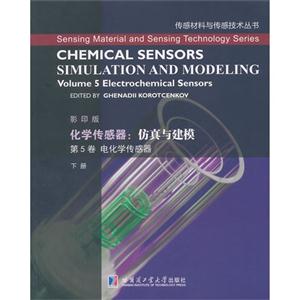-
>
湖南省志(1978-2002)?铁路志
-
>
公路车宝典(ZINN的公路车维修与保养秘籍)
-
>
晶体管电路设计(下)
-
>
无头案:雍正暴亡之谜
-
>
基于个性化设计策略的智能交通系统关键技术
-
>
花样百出:贵州少数民族图案填色
-
>
识木:全球220种木材图鉴
第5卷 电化学传感器 下册-化学传感器:仿真与建模-影印版 版权信息
- ISBN:9787560348995
- 条形码:9787560348995 ; 978-7-5603-4899-5
- 装帧:一般胶版纸
- 册数:暂无
- 重量:暂无
- 所属分类:>>
第5卷 电化学传感器 下册-化学传感器:仿真与建模-影印版 本书特色
this series,chemical sensors:simulation and mod.eling,is the perfect complement to momentum press's six-volume reference series,chemical sensors:fundamentals of sensing materials and chemical sensors: comprehensive sensor technologies,which present detailed information about materials,technologies,fabrication,and applications of various devices for chemical sensing.chemical sensors are integral to the automation of myriad industrial processes and everyday monitoring of such activities as public safety,engine performance,medical therapeutics,and many more.
第5卷 电化学传感器 下册-化学传感器:仿真与建模-影印版 内容简介
This series,Chemical Sensors:Simulation and Mod.eling,is the perfect complement to Momentum Press's six-volume reference series,Chemical Sensors:Fundamentals of Sensing Materials and Chemical Sensors: Comprehensive Sensor Technologies,which present detailed information about materials,technologies,fabrication,and applications of various devices for chemical sensing.Chemical sensors are integral to the automation of myriad industrial processes and everyday monitoring of such activities as public safety,engine performance,medical therapeutics,and many more.
第5卷 电化学传感器 下册-化学传感器:仿真与建模-影印版 目录
about the editor
contributors
part 3: electrochemical biosensors
7 nanomaterial-based electrochemical biosensors n.jaffrezic-renault
1 introduction
2 nanomaterials: fabrication, chemical and physical properties
2.1 conducting nanomaterials
2.2 nonconducting nanomaterials: magnetic nanoparticles
3 conception and modeling of amplification effect in nanomaterial-based enzyme sensors
3.1 aunps-based amperometric sensors
3.2 cnt-based amperometric sensors
3.3 mnp-based amperometric biosensors
3.4 potentiometric sensors
3.5 conductometric and impedimetric biosensors
4 conception and modeling of amplification effect in nanomaterial-based immunosensors
4.1 aunp-based amperometric immunosensors
4.2 aunp-based potentiometric sensors
4.3 impedimetric sensors
4.4 conductometric sensors
5 conception and modeling of amplification effect in nanomaterial-based dna biosensors
5.1 amperometric sensors
5.2 impedimetric sensors
6 conclusion
references
8 ion-sensitive field-effect transistors with nanostructured channels and nanoparticle-modified gate surfaces: theory,modeling and analysis
v k. khanna
1 introduction
2 structural configurations of the nanoscale isfet
2.1 the nanoporous silicon isfet
2.2 the cnt isfet
2.3 the si-nw isfet
3 physics of the si-nw biosensor
3.1 basic principle
3.2 analogy with the nanocantilever
3.3 preliminary analysis of micro-isfet downscaling to nano-isfet
3.4 single-gate and dual-gate nanowire sensors
3.5 energy-band model of the nw sensor
4 nair-alam model of si-nw biosensors
4.1 the three regions in the biosensor
4.2 computational approach
4.3 effect of nanowire diameter (d) on sensitivity at different doping densities, with air as the surrounding medium
4.4 effect of nanowire length (l) on sensitivity at different doping densities, with air as the surrounding medium
4.5 effect of the fluidic environment
4.6 overall model implications
5 ph response of silicon nanowires in terms of the site-binding and gouy-chapman-stern models
6 subthreshold regime as the optimal sensitivity regime of nanowire biosensors
7 effective capacitance model for apparent surpassing of the nernst limit by sensitivity of the dual-gate nw sensor
8 tunnel field-effect transistor concept
9 role of nanoparticles in isfet gate functionalization
……
9 biosensors: modeling and simulation of diffusion-limited processes
index
第5卷 电化学传感器 下册-化学传感器:仿真与建模-影印版 作者简介
Ghenadii Korotcenkov,received his Ph.D. in Physics and Technology of Semiconductor Materials and Devices in 1976, and his Habilitate Degree (Dr.Sci.) in Physics and Mathematics of Semiconductors and Dielectrics in 1990. For a long time he was a leader of the scientific Gas Sensor Group and manager of various national and international scientific and engineering projects carried out in the Laboratory of Micro-and Optoelectronics,Technical University of Moldova.Currently, Dr. Korotcenkov is a research professor at the Gwangju Institute of Science and Technology,Republic of Korea. Specialists from the former Soviet Union know Dr. Korotcenkov's research results in the field of study of Schottky barriers,MOS structures, native oxides,and photoreceivers based on Group III-V compounds very well. His current research interests include materials science and surface science,focused on nanostructured metal oxides and solid-state gas sensor design. Dr. Korotcenkov is the author or editor of 11 books and special issues,11 invited review papers,17 book chapters,and more than 190 peer-reviewed articles. He holds 18 patents,and he has presented more than 200 reports at national and international conferences. Dr. Korotcenkov's research activities have been honored by an Award of the Supreme Council of Science and Advanced Technology of the Republic of Moldova (2004),The Prize of the Presidents of the Ukrainian, Belarus, and Moldovan Academies of Sciences (2003), Senior Research Excellence Awards from the Technical University of Moldova (2001,2003,2005),a fellowship from the International Research Exchange Board (1998), and the National Youth Prize of the Republic of Moldo
- >
月亮虎
月亮虎
¥15.4¥48.0 - >
回忆爱玛侬
回忆爱玛侬
¥12.5¥32.8 - >
李白与唐代文化
李白与唐代文化
¥9.9¥29.8 - >
小考拉的故事-套装共3册
小考拉的故事-套装共3册
¥36.7¥68.0 - >
名家带你读鲁迅:朝花夕拾
名家带你读鲁迅:朝花夕拾
¥10.5¥21.0 - >
二体千字文
二体千字文
¥16.0¥40.0 - >
有舍有得是人生
有舍有得是人生
¥19.4¥45.0 - >
山海经
山海经
¥19.2¥68.0
-
2022图书×抽奖盲袋
¥9.9¥25 -
2023读书月阅读盲盒——天黑,闭眼,刀谁?
¥42.3¥158 -
2022读者节纪念徽章-三星会员专属
¥45¥45.6 -
2023读书月阅读盲盒——我什么场面没见过?
¥42.3¥158 -
2023读书月阅读盲盒——去码头整点什么薯条?
¥42.3¥158















